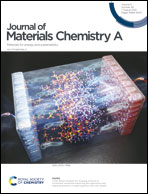A programmable powerful and ultra-fast water-driven soft actuator inspired by the mutable collagenous tissue of the sea cucumber†
Abstract
The sea cucumber evolved to bear mutable collagenous tissue (MCT) that enables its elastic modulus to change by a factor of 10 within a few seconds. It does this by controlling the amount of chemical regulator released, which can subsequently form or break hydrogen bonds within the MCT. Although existing water-driven, self-operating, soft actuators have great potential for soft robotics, they remain fragile and slow; ergo, their range of application remains modest. Inspired by MCT, we introduce a programmable, powerful, and ultra-fast water-driven self-operating soft actuator exerting an actuation force of approximately 2 N with an actuation speed of approximately 3 s−1 in 80 °C water based on the dramatic stiffness alteration of bulk poly(N-isopropylacrylamide) hydrogel. This actuator also exhibits outstanding robustness by preserving its original shape over multiple cycles of highly strained (300%) actuations under harsh environments. A simple modulation of cross-linker concentration with its dimensional adjustment enabled the precise tuning of not only the actuation force but also the actuation speed in a wide range. Thus, the soft robotic gripper was able to perform a myriad of intricate tasks such as capturing a fragile object, acting as a biomedical appliance, and closing a large wound with uniform appropriate forces.

- This article is part of the themed collection: Journal of Materials Chemistry A Lunar New Year collection 2022


 Please wait while we load your content...
Please wait while we load your content...